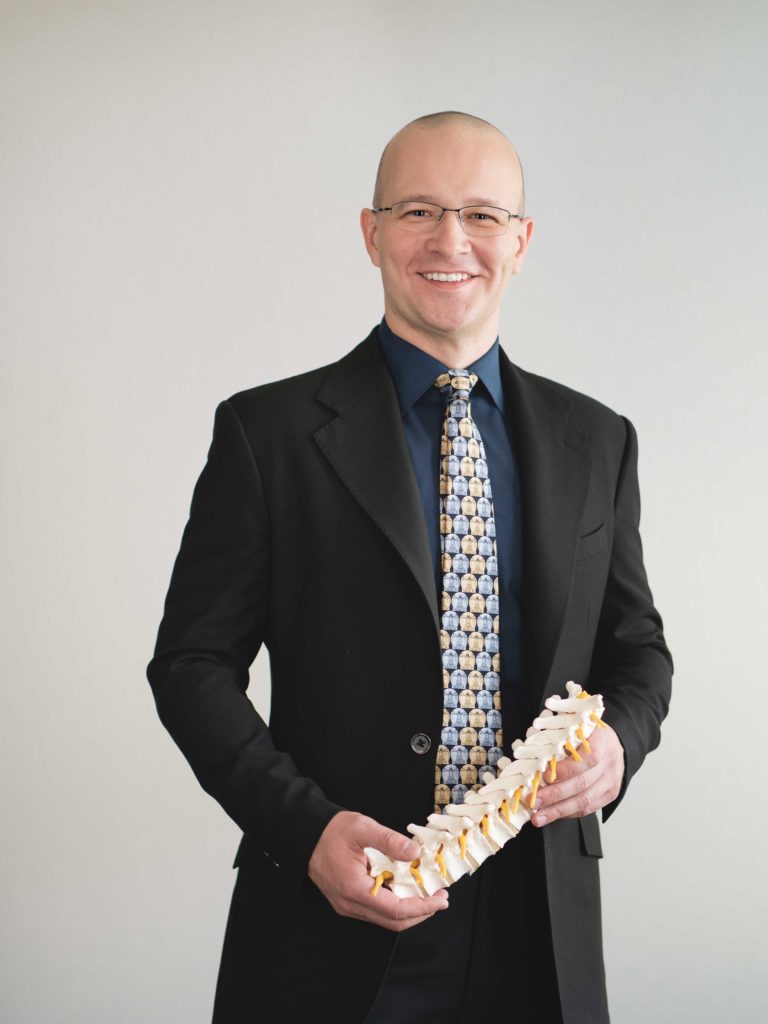More than twenty-five years ago, Dr. Vladimir Sinkov came from Russia to study as a high school exchange student in Kansas. Enthralled by experiences in a new world, he decided to stay in America and study medicine at John Hopkins University. In 2010, he completed his spine surgery fellowship from St. Joseph Hospital in Baltimore. After ten years of mastering spine surgery, Dr. Sinkov finally decided it was time to open his own private practice.

In June 2020, Dr. Sinkov and his wife launched Sinkov Spine Center in Las Vegas. However, opening a new business right smack in the middle of a pandemic did present quite a few challenges that Dr. Sinkov discusses a little bit more of below. Despite the less-than-ideal circumstances, Dr. Sinkov told Top Doctor Magazine that he feels very blessed by the continual growth of his practice.
The Real Issue of Opening a Practice During a Pandemic
The COVID-19 pandemic has been a struggle for many business owners. Countless enterprises had to shut down, but for those fortunate enough to continue running, the new reality challenged them to adapt to new safety precautions like constant disinfecting, temperature-checking, and social distancing; this, however, was not a struggle for Dr. Sinkov. Since he opened his business during the height of the pandemic, the new “normal” of doing things is, well, just “normal.”
The real issue, aside from the unpredictability of running a business in these unprecedented times, was dealing with insurance companies that reduce reimbursement rates for doctors, especially those in smaller independent practices. Dr. Sinkov revealed to Top Doctor Magazine the shockingly offensive rates that one insurance company tried to offer him: “Probably the worst was Blue Cross Blue Shield. They offered us less than 50% of what Medicare pays. And, just to put it into perspective, when I was in the Northeast, Medicare was the lowest reimbursing insurance that we had.” Dr. Sinkov said that the company offered less than $13 for a visit with a fellowship-trained spine surgeon with ten years of experience. “Some people pay more for a cup of coffee,” he said.
Dr. Sinkov believes that health insurance companies are not in the business to help patients or doctors, but rather, they are in the business with the sole purpose of making money. That is why Dr. Sinkov is choosing to opt-out from working with them and going for a direct-pay model, wherein the patients pay their physicians directly. Contrary to popular belief, if you consider the ever-increasing health insurance premiums, patients overall spend less this way because you cut out billing, collection, and service expenses. This type of arrangement is more beneficial to both the patient and the physician. Patients also regain control over their care because there are no referrals needed and there is no insurance company clerk to deny payment for care.

What’s So Cool About Spine Surgery Anyway?
So now, let’s dig a little deeper into the backbone of Dr. Sinkov’s practice (no pun intended). Dr. Sinkov specializes in surgical treatments of spine such as decompression, fusion, disc replacement, minimally invasive, and robotic spine surgery.
When people get spine surgery, it is usually because of a degenerative condition like arthritis or a herniated disc. Nerve compression causes patients to experience pain in their legs or arms. Dr. Sinkov can address this with decompression surgery. When a patient has more significant structural problems in the spine, like deformity or instability, Dr. Sinkov treats it with fusion surgery, wherein he fuses two or more bones so that they no longer move. The excessive motion of the bones can cause severe back and leg pain, so by linking them, Dr. Sinkov alleviates the problem.
However, performing surgery on the spine is not a walk in the park. The biggest challenge that spine surgeons face is how to get to the spine without too much damage to the surrounding tissues. Because the spine is located in the middle of the body, a surgeon has to get through a lot of muscles and safely around major organs and blood vessels to get to the vertebra and the nerves. With traditional fusion surgeries this means big incisions, significant bleeding, a lot of pain, long recovery, and a risk of complications. This makes a lot of people afraid to undergo spine surgery because it is so invasive with many potential negative repercussions. Dr. Sinkov utilizes new minimally invasive techniques to get to the spine safely through small incisions to fuse the bones and get the pressure off the nerves. This results in less bleeding, less pain, and quicker recovery and return to normal function with much lower risk of complications.
To aid in this minimally invasive process, Dr. Sinkov uses the ExcelsiusGPS® robot that he helped develop together with Globus Medical. Dr. Sinkov walked us through the process of how it works: “We’ll get a CT scan of the spine before surgery and then load it into the robot. I pre-program the trajectory of all the screws where they need to go. During the surgery, we basically tell the robot where to go with a push of a button. The robot orients a little tube over the trajectory for the screw, and I put it in through a minimal incision with high precision. The robot knows the anatomy of the patient, so I’m avoiding all the tissues and organs I don’t want to hurt.” Helping his patients feel better with minimally invasive robotic spine surgery is where Dr. Sinkov’s passion lies.
When asked about his take on regenerative medicine and stem cell surgery, Dr. Sinkov admits that he uses stem cells when performing fusion surgery. He incorporates his patient’s own stem cells or sometimes a cadaver bone’s stem cells to help speed up the fusion and healing process. However, he does not necessarily use stem cells to regenerate the spine structures because the technology is not at that level yet. When it does arrive, he will be sure to apply it in his practice. Meanwhile, his best advice for rejuvenating your spine is staying healthy, avoiding bad habits, and keeping your spine and muscles in good shape.

Robots and Augmented Reality Are The Future
As we continue moving forward in this digital age, Dr. Sinkov sees a bright future for minimally invasive surgeries. Aside from upgrading the spine assistant robots’ functions, he is also excited to see how augmented reality will play a key role in future surgeries. Although augmented reality technology is still in its early stages of development, Dr. Sinkov looks forward to one day being able to navigate through a patient’s tissue layers to the spine by using special goggles.
He believes that minimally invasive surgeries will be the only way to do surgeries in the near future. It takes time to learn how to do it, but he is happy to teach the new techniques to aspiring surgeons. After a brief pause due to COVID, Dr. Sinkov is back to teaching medical students how to treat patients with spine problems and how to perform this kind of surgery in a real-life hospital setting.

The Reason Why Healthcare Is So Expensive
Of course, with all the fantastic perks that come with being a surgeon, there are also some downsides. Dr. Sinkov opened up about the poor state of the American medical system. “There’s tons and tons of waste and inefficiency in healthcare because it’s not really a market economy-driven industry. A doctor’s ability to care for their patients is constantly stifled by a mixture of burdensome government regulations, unreasonable insurance rules, and fear of litigation.”
Dr. Sinkov cited the HIPAA and HITECH laws as an example. Initially, the laws sounded like a great idea that would help protect patient’s health information and create accessible electronic medical records. The implementation of the laws, however, was extremely burdensome and poorly thought through. The compliance requirements ended up causing doctors to pay hundreds of thousands of dollars for legal consultants and new computer systems and software to store medical information electronically – which, in turn, made healthcare more expensive to the patient.
Another reason why healthcare is so expensive is that suing doctors for medical malpractice is so common in the U.S that, in most places, it is a requirement for a doctor to have malpractice insurance before they are allowed to practice. Dr. Sinkov even got sued one time for not ordering an extra MRI, which in his opinion was unnecessary. Although he was proven innocent and the charges were dismissed, Dr. Sinkov spent precious time and money to get through the lawsuit, the time he could have spent treating patients. “The efforts required to avoid unnecessary and frivolous lawsuits are causing doctors to do a lot of work that has nothing to do with helping patients,” Dr. Sinkov stated.
In a healthcare system where insurance companies are only concerned about the dollars they pocket from the unsuspecting public, Dr. Sinkov refuses to be a part of a rigged system. Instead, he would go about medicine the old-fashioned way, where his patients get high quality care without administrative hurdles or unnecessary expenses.





0 Comments